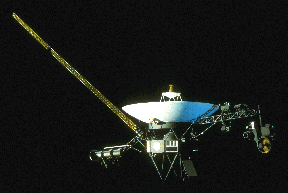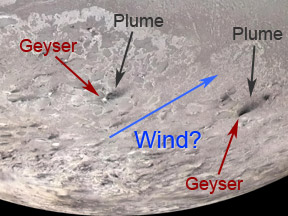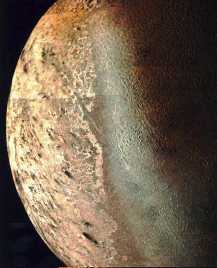This is an image of Triton.
Click on image for full size
NASA
Global Warming Not Simply Constrained to the Earth
News story originally written on June 26, 1998
It seems that global warming is not simply constrained to the Earth. Observations taken by the Hubble telescope show that
Neptune's largest moon, Triton, has heated up since the
Voyager spacecraft flew by in 1989.
Triton's overall average temperature has increased by 5%, a very large increase for such a short period of time. This increase in temperature is of course having global effects. One of the main things that this warming does is turn the frozen nitrogen surface of Triton into gas, making its atmosphere thicker. A thicker atmosphere and warmer temperatures may be more conducive to life on Triton. But, one must realize that even with this global warming, Triton is still very cold! Triton's temperature has risen from about -392 degrees Fahrenheit to -389 degrees Fahrenheit.
"With Triton, we can more easily study environmental changes because of its simple, thin atmosphere," Dr. Elliot of MIT explained. By studying these changes on Triton, scientists hope to gain new insight into the Earth's more complex environment.
You might also be interested in:

The rare geometric arrangement of planets Jupiter, Saturn, Uranus, and Neptune in the 1980's made it possible for the Voyager spacecrafts to visit them over a 12 year span instead of the normal 30. They
...more
Triton, by far the largest moon of Neptune, is slightly smaller than Earth's Moon. Triton has the coldest surface temperatures in our Solar System. Surprisingly, this frigid moon has an atmosphere, albeit
...more
It was another exciting and frustrating year for the space science program. It seemed that every step forward led to one backwards. Either way, NASA led the way to a great century of discovery. Unfortunately,
...more
The Space Shuttle Discovery lifted off from Kennedy Space Center at 2:19 p.m. EST, October 29th. The sky was clear and the weather was great as Discovery took 8 1/2 minutes to reach orbit for the Unitied
...more
A moon was discovered orbiting the asteroid, Eugenia. This is only the second time in history that a satellite has been seen circling an asteroid. A special mirror allowed scientists to find the moon
...more
Will Russia ever put the service module for the International Space Station in space? NASA officials are demanding an answer from the Russian government. The necessary service module is currently waiting
...more
During a period of about two days in early May, 1998, the ACE spacecraft was immersed in plasma associated with a coronal mass ejection (CME). The SWICS instrument on ACE, which determines unambiguously
...more















